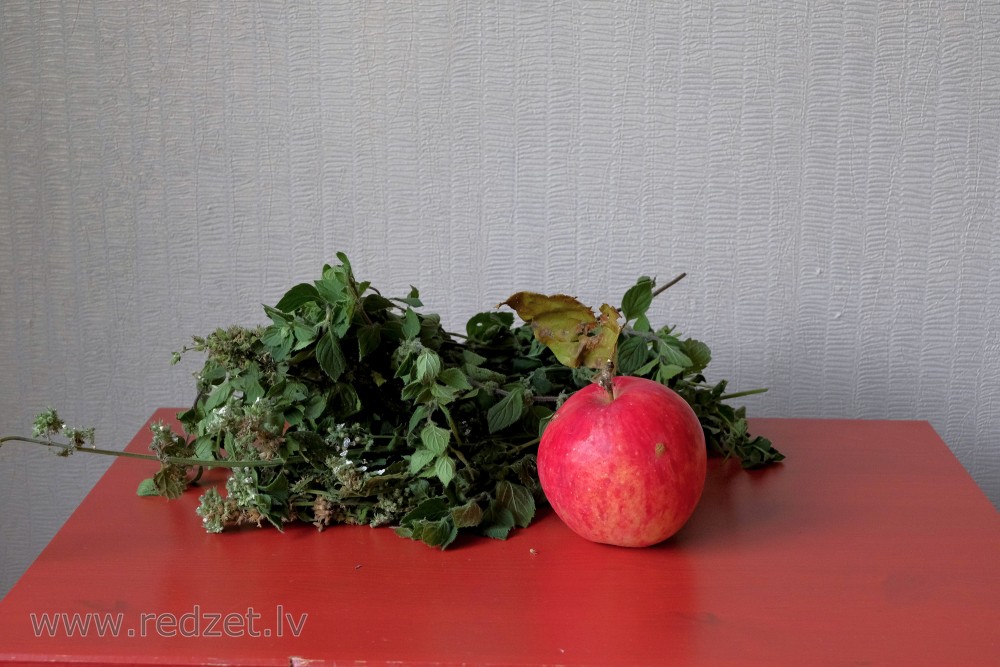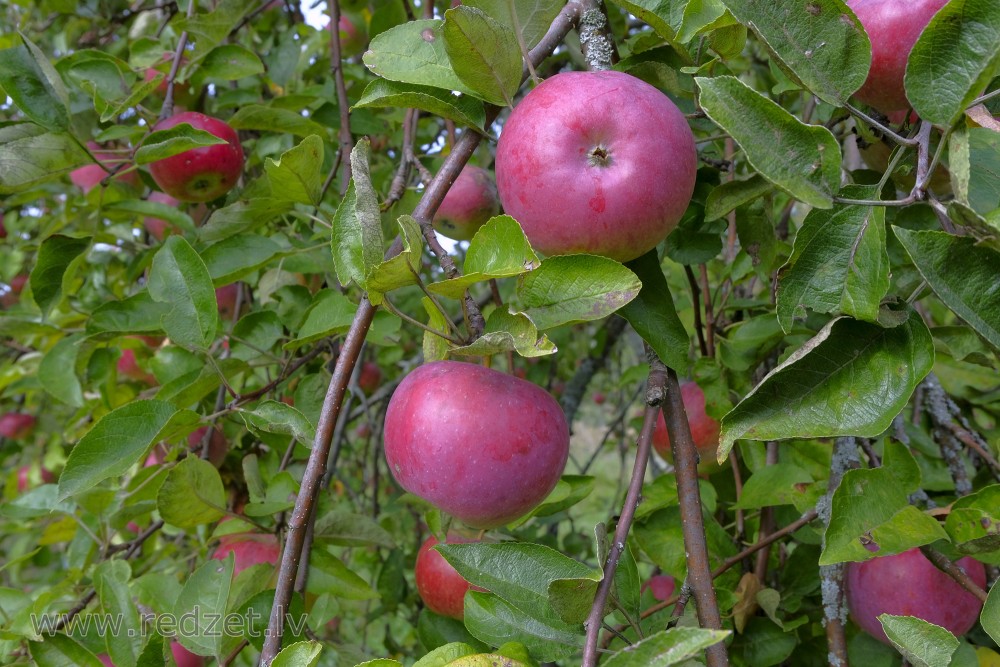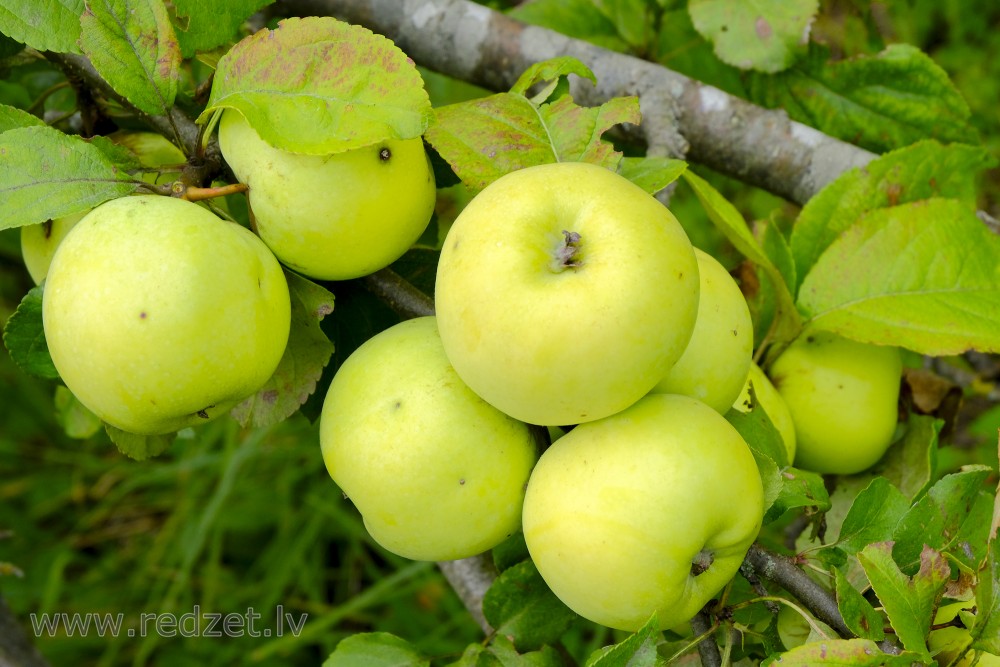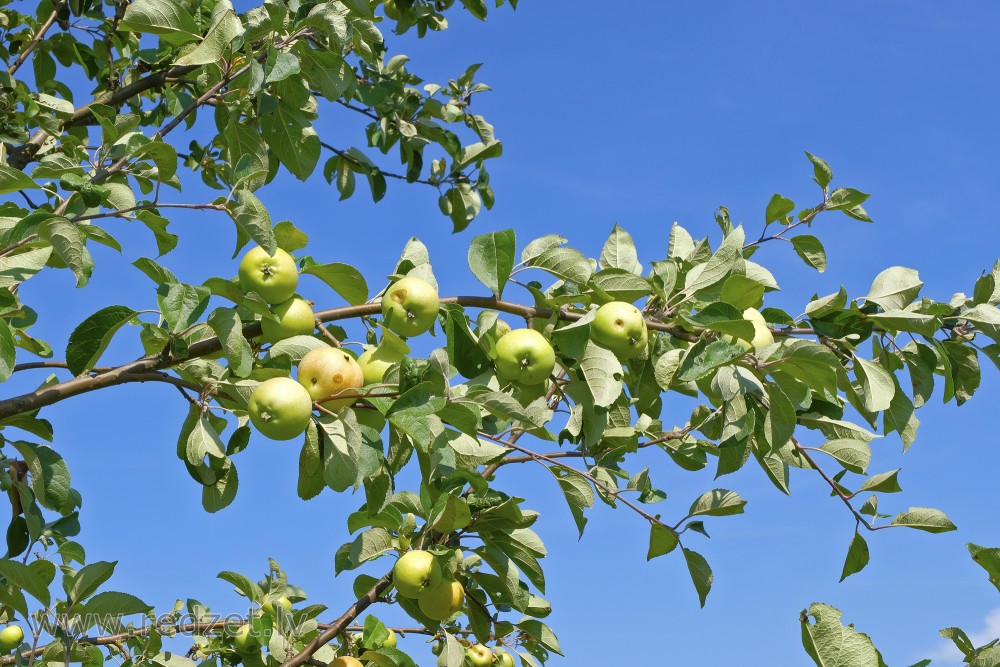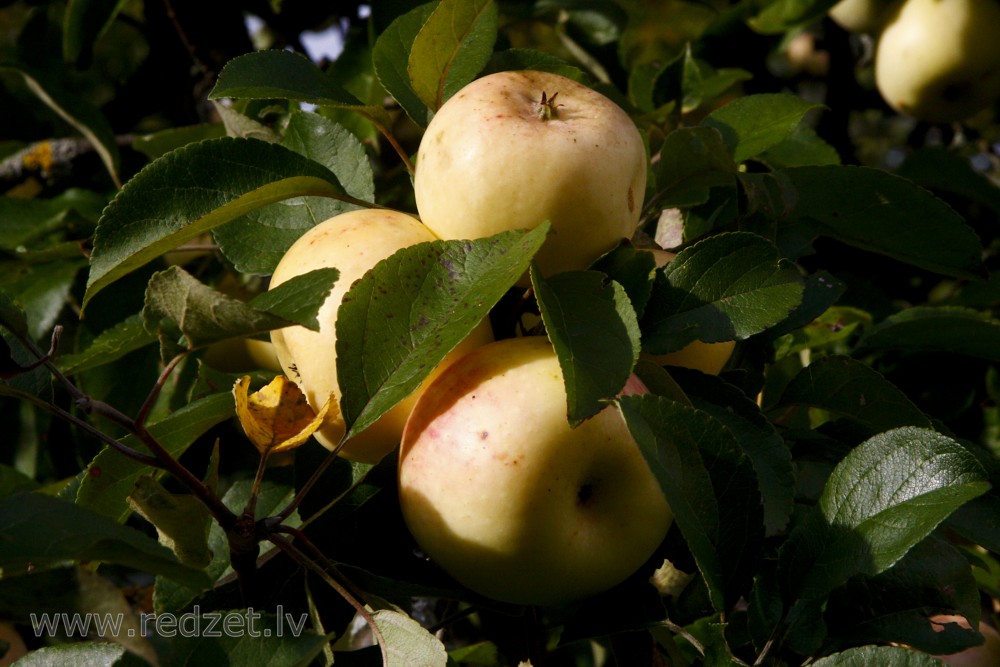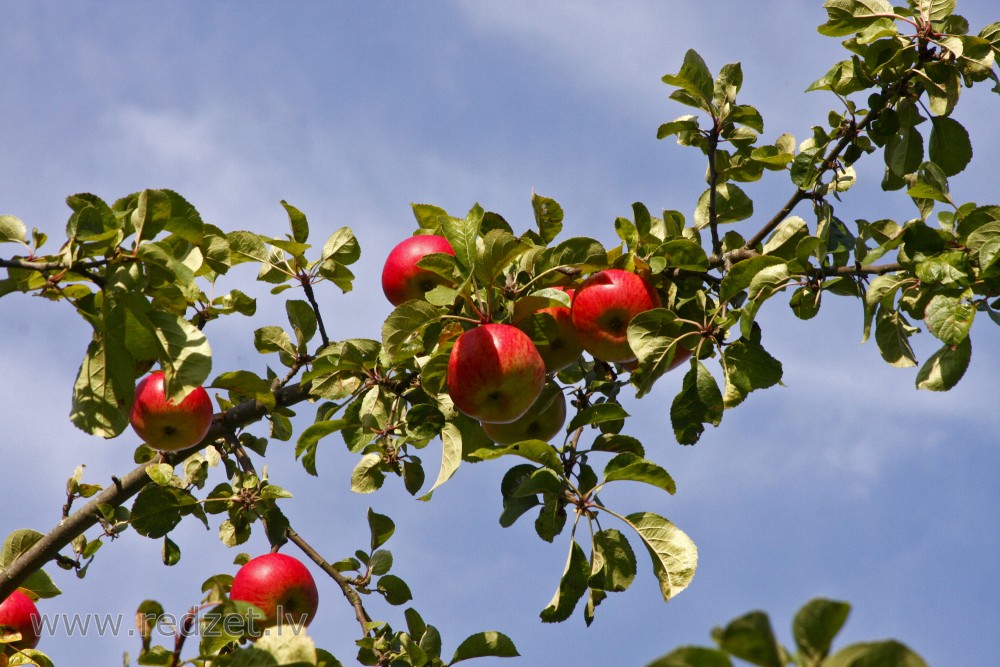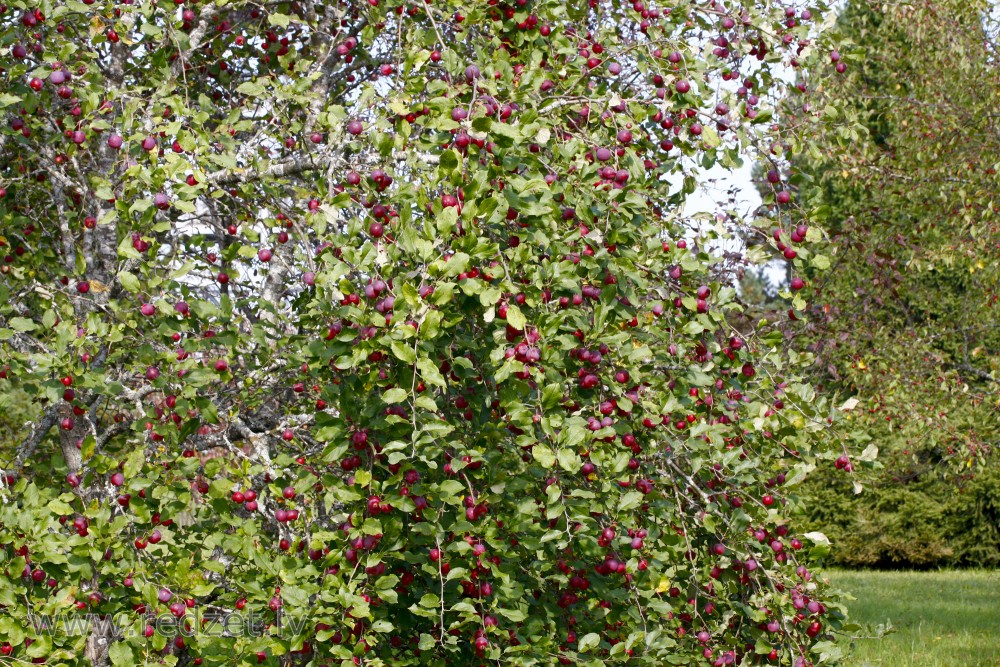Apple
An apple is a sweet, edible fruit produced by an apple tree (Malus pumila). Apple trees are cultivated worldwide, and are the most widely grown species in the genus Malus. The tree originated in Central Asia, where its wild ancestor, Malus sieversii, is still found today. Apples have been grown for thousands of years in Asia and Europe, and were brought to North America by European colonists. Apples have religious and mythological significance in many cultures, including Norse, Greek and European Christian traditions.
Apple trees are large if grown from seed. Generally apple cultivars are propagated by grafting onto rootstocks, which control the size of the resulting tree. There are more than 7,500 known cultivars of apples, resulting in a range of desired characteristics. Different cultivars are bred for various tastes and uses, including cooking, eating raw and cider production. Trees and fruit are prone to a number of fungal, bacterial and pest problems, which can be controlled by a number of organic and non-organic means. In 2010, the fruit's genome was sequenced as part of research on disease control and selective breeding in apple production.
Worldwide production of apples in 2014 was 84.6 million tonnes, with China accounting for 48% of the total.
Cultivars
There are more than 7,500 known cultivars of apples.[36] Cultivars vary in their yield and the ultimate size of the tree, even when grown on the same rootstock. Different cultivars are available for temperate and subtropical climates. The UK's National Fruit Collection, which is the responsibility of the Department of Environment Food and Rural Affairs, includes a collection of over 2,000 cultivars of apple tree in Kent. The University of Reading, which is responsible for developing the UK national collection database, provides access to search the national collection. The University of Reading's work is part of the European Cooperative Programme for Plant Genetic Resources of which there are 38 countries participating in the Malus/Pyrus work group.
The UK's national fruit collection database contains a wealth of information on the characteristics and origin of many apples, including alternative names for what is essentially the same "genetic" apple cultivar. Most of these cultivars are bred for eating fresh (dessert apples), though some are cultivated specifically for cooking (cooking apples) or producing cider. Cider apples are typically too tart and astringent to eat fresh, but they give the beverage a rich flavor that dessert apples cannot.
Commercially popular apple cultivars are soft but crisp. Other desired qualities in modern commercial apple breeding are a colorful skin, absence of russeting, ease of shipping, lengthy storage ability, high yields, disease resistance, common apple shape, and developed flavor. Modern apples are generally sweeter than older cultivars, as popular tastes in apples have varied over time. Most North Americans and Europeans favor sweet, subacid apples, but tart apples have a strong minority following. Extremely sweet apples with barely any acid flavor are popular in Asia and especially Indian Subcontinent .
Old cultivars are often oddly shaped, russeted, and have a variety of textures and colors. Some find them to have a better flavor than modern cultivars, but they may have other problems which make them commercially unviable—low yield, disease susceptibility, poor tolerance for storage or transport, or just being the "wrong" size. A few old cultivars are still produced on a large scale, but many have been preserved by home gardeners and farmers that sell directly to local markets. Many unusual and locally important cultivars with their own unique taste and appearance exist; apple conservation campaigns have sprung up around the world to preserve such local cultivars from extinction. In the United Kingdom, old cultivars such as 'Cox's Orange Pippin' and 'Egremont Russet' are still commercially important even though by modern standards they are low yielding and susceptible to disease.
Production
World production of apples in 2016 was 89.3 million tonnes, with China producing 50% of the world total (table). Other major producers with 5% or less of the world total each were the United States, Poland, Turkey, India, and Iran.
Nutrition
A typical apple serving weighs 242 grams and provides 126 calories with a moderate content of dietary fiber (table). Otherwise, there is generally low content of essential nutrients (table).
Human consumption
The whole fruit including the skin, except for the seeds, is suitable for human consumption. The core, containing the seeds, is usually not eaten and is discarded.
Apples can be consumed various ways: juice, raw in salads, baked in pies, cooked into sauces, and other baked dishes.
Several techniques are used to preserve apples and apple products. Apples can be canned, dried or frozen. Canned or frozen apples are eventually baked into pies or other cooked dishes. Apple juice or cider is also bottled. Apple juice is often concentrated and frozen.
Popular uses
Apples are often eaten raw. Cultivars bred for raw consumption are termed dessert or table apples.
- In the UK, a toffee apple is a traditional confection made by coating an apple in hot toffee and allowing it to cool. Similar treats in the U.S. are candy apples (coated in a hard shell of crystallized sugar syrup), and caramel apples (coated with cooled caramel).
- Apples are eaten with honey at the Jewish New Year of Rosh Hashanah to symbolize a sweet new year.
Apples are an important ingredient in many desserts, such as apple pie, apple crumble, apple crisp and apple cake. When cooked, some apple cultivars easily form a puree known as apple sauce. Apples are also made into apple butter and apple jelly. They are often baked or stewed and are also (cooked) in some meat dishes. Dried apples can be eaten or reconstituted (soaked in water, alcohol or some other liquid).
Apples are milled or pressed to produce apple juice, which may be drunk unfiltered (called apple cider in North America), or filtered. Filtered juice is often concentrated and frozen to be reconstituted later and consumed. Apple juice can be fermented to make cider (called hard cider in North America), ciderkin, and vinegar. Through distillation, various alcoholic beverages can be produced, such as applejack, Calvados, and apfelwein.
Sliced apples turn brown with exposure to air due to the conversion of natural phenolic substances into melanin upon exposure to oxygen. Different cultivars vary in their propensity to brown after slicing and the genetically engineered Arctic Apples do not brown. Sliced fruit can be treated with acidulated water to prevent this effect. Sliced apple consumption tripled in the US from 2004 to 2014 to 500 million apples annually due to its convenience.
Organic production
Organic apples are commonly produced in the United States. Due to infestations by key insects and diseases, organic production is difficult in Europe. The use of pesticides containing chemicals, such as sulfur, copper, microorganisms, viruses, clay powders, or plant extracts (pyrethrum, neem) has been approved by the EU Organic Standing Committee to improve organic yield and quality. A light coating of kaolin, which forms a physical barrier to some pests, also may help prevent apple sun scalding.
Phytochemicals
Apples are a rich source of various phytochemicals including flavonoids (e.g., catechins, flavanols, and quercetin) and other phenolic compounds (e.g., epicatechin and procyanidins) found in the skin, core, and pulp of the apple; they have unknown health value in humans.
Phenolic compounds, such as polyphenol oxidase, are the main driving force behind browning in apples. Polyphenol oxidase catalyzes the reaction of phenolic compounds to o-quinones causing the pigment to turn darker and therefore brown.
Ideain (cyanidin 3-O-galactoside) is an anthocyanin, a type of pigment, which is found in some red apple cultivars.
Phlorizin is a flavonoid that is found in apple trees, particularly in the leaves, and in only small amounts if at all in other plants, even other species of the genus Malus or related plants such as pear trees.
en.wikipedia.org









